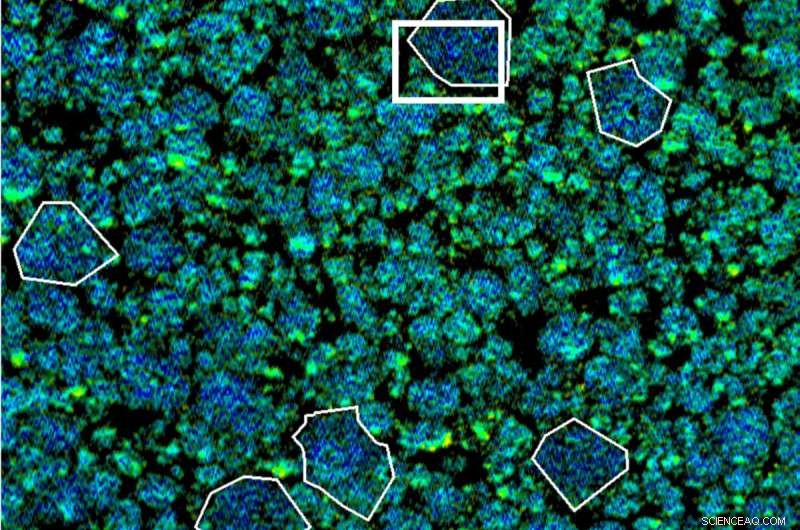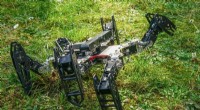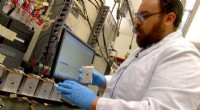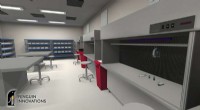Hvordan røntgenstråler kan skabe bedre batterier

Detaljerede røntgenmålinger ved Advanced Light Source hjalp et forskerhold ledet af Berkeley Lab, SLAC og Stanford University med at afsløre, hvordan ilt siver ud af de milliarder af nanopartikler, der udgør lithium-ion batterielektroder. Kredit:Berkeley Lab
Over en tre-måneders periode producerer den gennemsnitlige bil i USA et metrisk ton kuldioxid. Gang det med alle de benzindrevne biler på Jorden, og hvordan ser det ud? Et uoverstigeligt problem.
Men nye forskningsindsatser siger, at der er håb, hvis vi forpligter os til netto-nul CO2-emissioner i 2050 og erstatter gasslugende køretøjer med elektriske køretøjer, blandt mange andre løsninger til ren energi.
For at hjælpe vores nation med at nå dette mål arbejder videnskabsmænd som William Chueh og David Shapiro sammen om at komme med nye strategier til at designe sikrere langdistancebatterier lavet af bæredygtige, jordrige materialer.
Chueh er lektor i materialevidenskab og ingeniørvidenskab ved Stanford University med det formål at redesigne det moderne batteri fra bunden og op. Han er afhængig af avancerede værktøjer på videnskabelige brugerfaciliteter i det amerikanske energiministerium, såsom Berkeley Labs Advanced Light Source (ALS) og SLACs Stanford Synchrotron Radiation Light Source - synkrotronfaciliteter, der genererer klare stråler af røntgenlys - for at afsløre batterimaterialernes molekylære dynamik på arbejde.
I næsten et årti har Chueh samarbejdet med Shapiro, en senior videnskabsmand ved ALS og en førende synkrotronekspert - og sammen har deres arbejde resulteret i fantastiske nye teknikker, der for første gang afslører, hvordan batterimaterialer fungerer i aktion, i realtid , i hidtil usete skalaer usynlige for det blotte øje.
De diskuterer deres banebrydende arbejde i denne Q&A.
Sp:Hvad fik dig til at interessere dig for forskning i batteri/energilagring?
Chueh:Mit arbejde er næsten udelukkende drevet af bæredygtighed. Jeg blev involveret i energimaterialeforskning, da jeg var kandidatstuderende i begyndelsen af 2000'erne - jeg arbejdede med brændselscelleteknologi. Da jeg kom til Stanford i 2012, blev det klart for mig, at skalerbar og effektiv energilagring er afgørende.
I dag er jeg meget spændt på at se, at energiomstillingen væk fra fossile brændstoffer nu er ved at blive en realitet, og at den bliver implementeret i utroligt omfang.
Jeg har tre mål:For det første laver jeg grundforskning, der lægger grundlaget for at muliggøre energiomstillingen, især med hensyn til materialeudvikling. For det andet træner jeg videnskabsmænd og ingeniører i verdensklasse, som vil gå ud i den virkelige verden for at løse disse problemer. Og for det tredje tager jeg den grundlæggende videnskab og oversætter den til praktisk brug gennem iværksætteri og teknologioverførsel.
Så forhåbentlig giver det dig et samlet overblik over, hvad der driver mig, og hvad jeg tror, der skal til for at gøre en forskel:Det er viden, mennesker og teknologi.
Shapiro:Min baggrund er inden for optik og sammenhængende røntgenspredning, så da jeg først begyndte at arbejde på ALS i 2012, var batterier ikke rigtig på min radar. Jeg fik til opgave at udvikle nye teknologier til røntgenmikroskopi med høj rumlig opløsning, men det førte hurtigt til applikationerne og forsøget på at finde ud af, hvad forskere ved Berkeley Lab og videre laver, og hvad deres behov er.
På det tidspunkt, omkring 2013, var der meget arbejde på ALS ved at bruge forskellige teknikker, der udnyttede den kemiske følsomhed af bløde røntgenstråler til at studere fasetransformationer i batterimaterialer, især lithiumjernfosfat (LiFePO4) blandt andre.
Jeg var virkelig imponeret over Wills arbejde såvel som over Wanli Yang, Jordi Cabana (en tidligere ansat videnskabsmand i Berkeley Labs Energy Technologies Area (ETA), som nu er lektor ved University of Illinois Chicago), og andre, hvis arbejde også byggede uden arbejde af ETA-forskerne Robert Kostecki og Marca Doeff.
I knew nothing about batteries at the time, but the scientific and social impact of this area of research quickly became apparent to me. The synergy of research across Berkeley Lab also struck me as very profound, and I wanted to figure out how to contribute to that. So I started to reach out to people to see what we could do together.
As it turned out, there was a great need to improve the spatial resolution of our battery materials measurements and to look at them during cycling—and Will and I have been working on that for nearly a decade now.
Q:Will, as a battery scientist, what would you say is the biggest challenge to making better batteries?
Chueh:Batteries have on the order of 10 metrics that you have to co-optimize at the same time. It's easy to make a battery that's good on maybe five out of the 10, but to make a battery that's good in every metric is very immensely challenging.
For example, let's say you want a battery that is energy dense so you can drive an electric car for 500 miles per charge. You may want a battery that charges in 10 minutes. And you may want a battery that lasts 20 years. You also want a battery that never explodes. But it's hard to meet all of these metrics at once.
What we're trying to do is understand how we can create a single battery technology that is safe, long-lasting, and can be charged in 10 minutes.
And those are the fundamental insights that our experiments at Berkeley Lab's Advanced Light Source are trying to do:To uncover those unexplained tradeoffs so that we can go beyond today's design rules, which would enable us to identify new materials and new mechanisms so that we can free ourselves from those restrictions.
Q:What unique capabilities does the ALS offer that have helped to push the boundaries of battery or energy storage research?
Chueh:In order to understand what's going on, we need to see it. We need to make observations. A key philosophy of my group is to embrace the dynamics and the heterogeneity of battery materials. A battery material is not like a rock. It's not static. You are charging and discharging it every day for your phones and every week for your electric cars. You're not going to understand how a car works by not driving it.
The second part is that heterogeneous battery materials are extremely length spanning. A battery cell is typically a few centimeters tall, but in order to understand what's going on inside the battery—and I have beautiful images for this—you want to see all the way down to the nanoscale and to the atomic scale. That's about 10 orders of magnitude of length.
What the Advanced Light Source empowers scientists like me to be able to do is to embrace the heterogeneity and dynamics of a battery in very unprecedented ways:We can measure very slow processes. We can measure very fast processes. We can measure things at the scale of many hundreds of microns (millionths of a meter). We can measure things at the nanoscale (billionth of a meter). All with one amazing tool at Berkeley Lab.
Shapiro:Scanning transmission X-ray microscopy (STXM) is a very popular synchrotron-based method. Most synchrotrons around the world have at least one STXM instrument while the ALS has three—and a fourth is on the way through the ALS Upgrade (ALS-U) project.
I think a few things make our program unique. First, we have a portfolio of instruments with specializations. One is optimized for light element spectroscopy so an element like oxygen, which is a critical ingredient in battery chemistry, can be precisely characterized.
Another instrument specializes in mapping chemical composition at very high spatial resolution. We have the highest spatial resolution X-ray microscopy in the world. This is very powerful for zooming in on the chemical reactions happening within a battery's individual nanoparticles and interfaces.
Our third instrument specializes in "operando" measurements of battery chemistry, which you need in order to really understand the physical and chemical evolution that occurs during battery cycling.
We have also worked hard to develop synergies with other facilities at Berkeley Lab. For instance, our high-resolution microscope uses the same sample environments as the electron microscopes at the Molecular Foundry, Berkeley Lab's nanoscience user facility—so it has become feasible to probe the same active battery environment with both X-rays and electrons. Will has used this correlative approach to study relationships between chemical states and structural strain in battery materials. This has never been done before at the length scales we have access to, and it provides new insight.
Q:How will the ALS Upgrade project advance next-gen energy storage technologies? What will the upgraded ALS offer battery/energy-storage researchers that will be unique to Berkeley Lab?
Shapiro:The upgraded ALS will be unique for a few reasons as far as microscopy is concerned. First, it will be the brightest soft X-ray source in the world, providing 100 times more X-rays on th sample than what we have today. Scanning microscopy techniques will benefit from such high brightness.
This is both a huge opportunity and a huge challenge. We can use this brightness to measure the data we get today—but doing this 100 times faster is the challenging part.
Such new capabilities will give us a much more statistically accurate look at battery structure and function by expanding to larger length scales and smaller time scales. Alternatively, we could also measure data at the same rate as today but with about three times finer spatial resolution, taking us from about 10 nanometers to just a few nanometers. This is a very important length scale for materials science, but today it's just not accessible by X-ray microscopy.
Another thing that will make the upgraded ALS unique is its proximity to expertise at the Molecular Foundry; other science areas such as the Energy Technologies Area; and current and future energy research hubs based at Berkeley Lab. This synergy will continue to drive energy storage research.
Chueh:In battery research, one of the challenges we have right now is that we have so many interesting problems to solve, but it takes hours and days to do just one measurement. The ALS-U project will increase the throughput of experiments and allow us to probe materials at higher resolution and smaller scales. Altogether, that adds up to enabling new science. Years ago, I contributed to making the case for ALS-U, so I couldn't be prouder to be part of that—I'm very excited to see the upgraded ALS come online so we can take advantage of its exciting new capabilities to do science that we cannot do today.
 Varme artikler
Varme artikler
-
 Robotter bliver programmeret til at tilpasse sig i realtidI forsøg, ResiBot-robotten lærte at gå igen på mindre end to minutter efter, at det ene ben blev fjernet. Kredit:Antoine Cully / Sorbonne University En robust, tilpasningsdygtig robot, der reagere
Robotter bliver programmeret til at tilpasse sig i realtidI forsøg, ResiBot-robotten lærte at gå igen på mindre end to minutter efter, at det ene ben blev fjernet. Kredit:Antoine Cully / Sorbonne University En robust, tilpasningsdygtig robot, der reagere -
 At lave mere sikre og kraftfulde lithium-ion-batterier kræver den rigtige opskriftIngeniører fra Purdue University, herunder doktorgradskandidat Daniel Robles (vist her), opdager mere om, hvordan litiumionbatterier fungerer - oplysninger, der burde gøre det mere sikkert, og batteri
At lave mere sikre og kraftfulde lithium-ion-batterier kræver den rigtige opskriftIngeniører fra Purdue University, herunder doktorgradskandidat Daniel Robles (vist her), opdager mere om, hvordan litiumionbatterier fungerer - oplysninger, der burde gøre det mere sikkert, og batteri -
 Virtuelt renrum kan øge sikkerheden, minimere risici, reducere uddannelsesomkostninger for farmaceu…Penguin Innovations, en Purdue University-tilknyttet startup, skabt et virtuelt interaktivt renrum for at lære fremtidige farmaceuter og teknikere, hvordan de korrekt forbereder og håndterer medicin o
Virtuelt renrum kan øge sikkerheden, minimere risici, reducere uddannelsesomkostninger for farmaceu…Penguin Innovations, en Purdue University-tilknyttet startup, skabt et virtuelt interaktivt renrum for at lære fremtidige farmaceuter og teknikere, hvordan de korrekt forbereder og håndterer medicin o -
 Rapport:Populær UAE-chat-app ToTok, et spionværktøj fra regeringenI denne 27. okt. 2013 filbillede, en arbejder ser på sin mobiltelefon i den nyåbnede Al Maktoum International Airport i Dubai, Forenede Arabiske Emirater. Ifølge en rapport fra New York Times, ToTok,
Rapport:Populær UAE-chat-app ToTok, et spionværktøj fra regeringenI denne 27. okt. 2013 filbillede, en arbejder ser på sin mobiltelefon i den nyåbnede Al Maktoum International Airport i Dubai, Forenede Arabiske Emirater. Ifølge en rapport fra New York Times, ToTok,
- Bevægelsesfremmende eksoskeletter kan hæmme beslutningstagningen
- Dette firma har til formål at beskytte tilsluttede biler mod cyberangreb
- Hawaii søger ende på stridigheder om astronomi på det hellige bjerg
- Sydafrika har brug for god vandforvaltning - ikke nye vandlove
- Rumsoftwarefirmaet ser stort løfte i små satellitter
- Anti-kræftlægemiddel brygget fra omprogrammeret gær


